A Tool for the Analysis and Characterization of School Mathematical Models
Abstract
:1. Introduction
- Define a set of categories that altogether make it possible to characterize the school mathematical model underlying a written production.
- Provide an analysis tool based on these categories, as well as an appropriate analysis procedure associated with such tool.
- Illustrate the use and results provided by the tool by applying it to two different modeling tasks.
Research Background
2. Materials and Methods
2.1. The Tool
2.2. Analysis Procedure
3. Results
3.1. Analysis of a Model for the Task “The President’s Supporters”
3.2. Analysis of a Model for the Task “The Play Center”
4. Discussion
4.1. What Does the Tool Provide for the Analysis of School Models?
4.2. Connection with Other Approaches
5. Conclusions
Author Contributions
Funding
Acknowledgments
Conflicts of Interest
Appendix A. Statement of the Task “The President’s Supporters” and Production Analyzed


Appendix B. Statement of the Task “The Play Center” and Production Analyzed
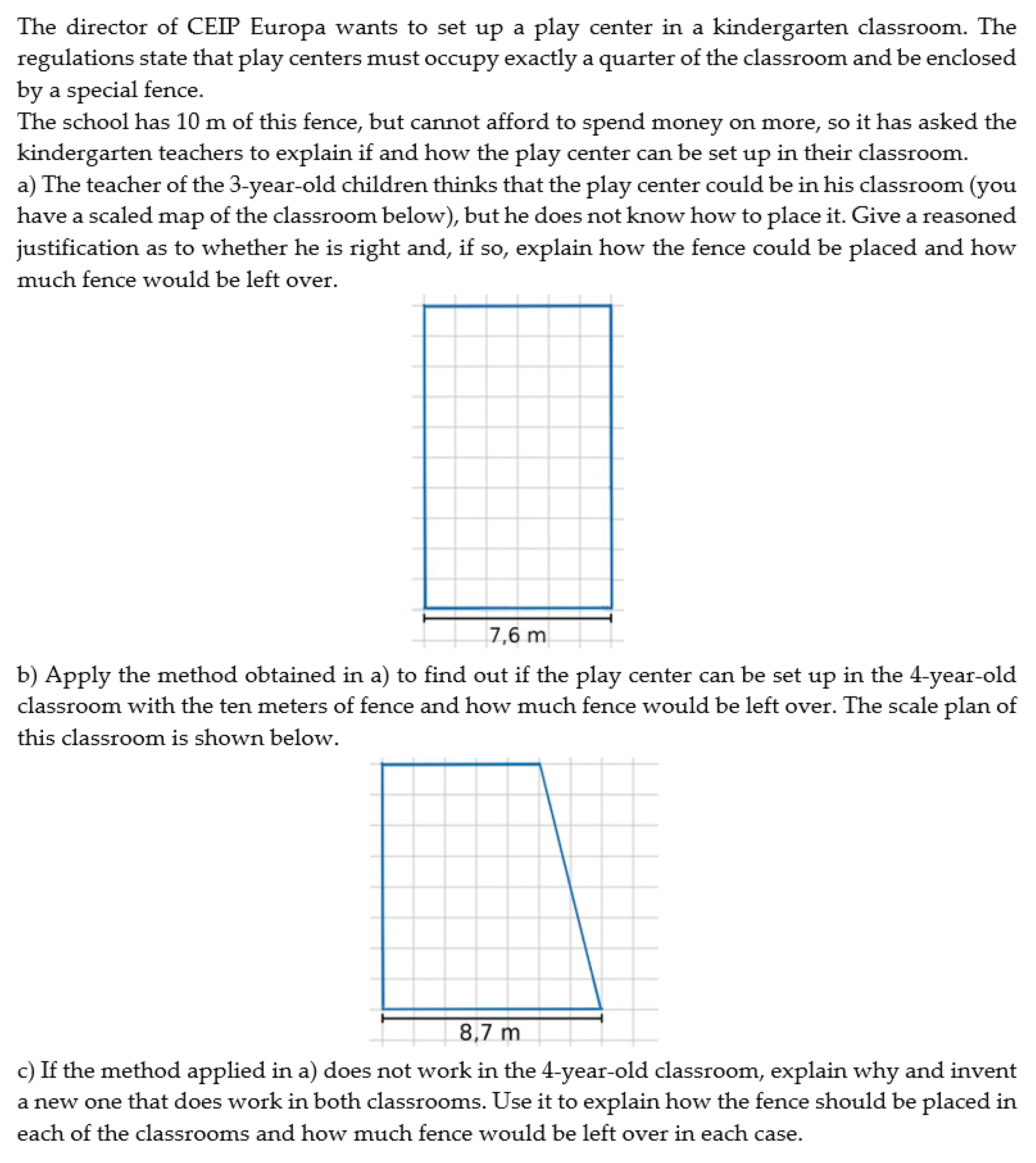

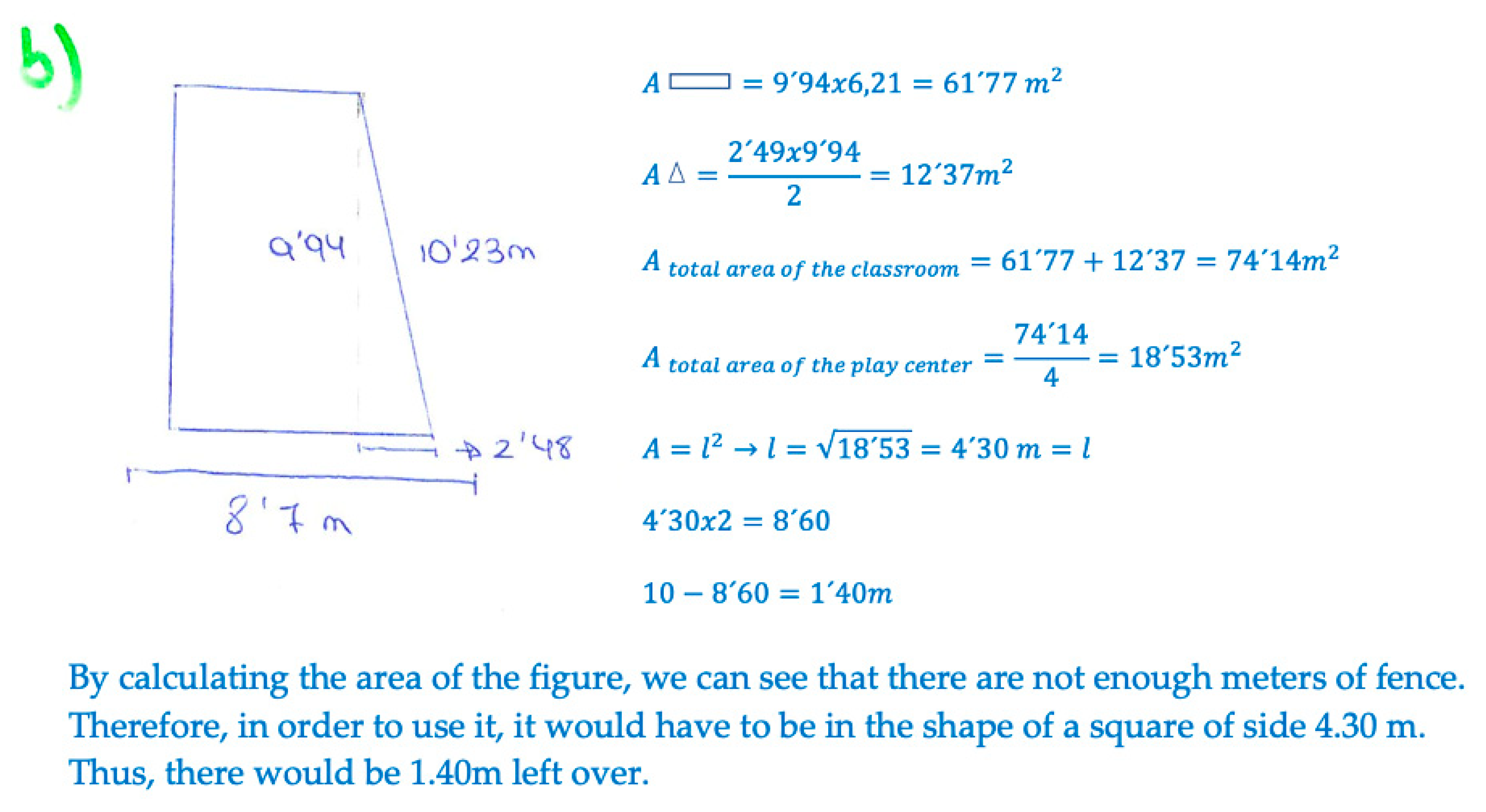

References
- Maaß, K.; Gurlitt, J. Designing a teacher questionnaire to evaluate professional development in modelling. In Proceedings of the Sixth Congress of the European Society for Research in Mathematics Education, Lyon, France, 28 January–1 February 2009; pp. 2056–2065. [Google Scholar]
- Niss, M.; Højgaard, T. Competencies and Mathematical Learning: Ideas and Inspiration for the Development of Mathematics Teaching and Learning in Denmark; Roskilde University: Roskilde, Denmark, 2011. [Google Scholar]
- Delgadillo, E.; Viola, F.; Vivier, L. Choosing a Mathematical Working Space in a modelling task: The influence of teaching. In Proceedings of the CERME10; Dooley, T., Gueudet, G., Eds.; DCU Institute of Education and ERME: Dublin, Ireland, 2017; pp. 956–963. [Google Scholar]
- Lehrer, R.; Schauble, L. Origins and evaluation of model-based reasoning in mathematics and science. In Beyond Constructivism: Models and Modeling Perspectives on Mathematics Problem Solving, Learning, and Teaching; Lesh, R., Doerr, H.M., Eds.; Lawrence Erlbaum: Mahwah, NJ, USA, 2003; pp. 59–70. [Google Scholar]
- Villarreal, M.E.; Mina, M. Actividades Experimentales con Tecnologías en Escenarios de Modelización Matemática. Bolema Bol. Educ. Mat. 2020, 34, 786–824. [Google Scholar] [CrossRef]
- Kaiser, G.; Blomhøj, M.; Sriraman, B. Towards a didactical theory for mathematical modelling. ZDM Math. Educ. 2006, 38, 82–85. [Google Scholar] [CrossRef]
- De Lange, J. Mathematics for Literacy. In Quantitative Literacy: Why Numeracy Matters for Schools and Colleges; Madison, B.L., Steen, L.A., Eds.; The National Council on Education and the Disciplines: Princeton, NJ, USA, 2003; pp. 75–89. [Google Scholar]
- Blum, W.; Galbraith, P.; Henn, H.W.; Niss, M. Modelling and Applications in Mathematics Education: The 14th ICMI Study; Springer: New York, NY, USA, 2007. [Google Scholar]
- Kaiser, G. Mathematical Modelling and Applications in Education. In Encyclopedia of Mathematics Education; Lerman, S., Ed.; Springer: Dordrecht, The Netherlands, 2014. [Google Scholar]
- Chevallard, Y.; Bosch, M.; Gascón, J. Estudiar Matemáticas. El Eslabón Perdido Entre la Enseñanza y el Aprendizaje; ICE/Horsori: Barcelona, Spain, 1997. [Google Scholar]
- Barquero, B. Enseñando Modelización a Nivel Universitario: la relatividad institucional de los recorridos de estudio e investigación. Bolema. Math. Educ. Bull. 2015, 29, 593–612. [Google Scholar] [CrossRef] [Green Version]
- Velten, K. Mathematical Modeling and Simulation; WILEY-Springer: Weinheim, Germany, 2009. [Google Scholar]
- Castro, E.; Castro, E. Representaciones y modelización. In La Educación Matemática en la Enseñanza Secundaria; Rico, L., Ed.; Horsori: Barcelona, Spain, 1997; pp. 95–124. [Google Scholar]
- Van den Heuvel-Panhuizen, M. The didactical use of models in realistic mathematics education: An example from a longitudinal trayectory on percentage. Educ. Stud. Math. 2003, 54, 9–35. [Google Scholar] [CrossRef]
- Borromeo-Ferri, R. Theoretical and empirical differentiations of phases in the modelling process. ZDM Math. Educ. 2006, 38, 86–95. [Google Scholar] [CrossRef]
- Greefrath, G.; Vorhölter, K. Teaching and Learning Mathematical Modelling: Approaches and Developments from German Speaking Countries. In Teaching and Learning Mathematical Modelling. ICME-13 Topical Surveys; Springer: Cham, Switzerland, 2016. [Google Scholar]
- Blum, W.; Leiß, D. How do students’ and teachers deal with modelling problems? In Mathematical Modelling: Education, Engineering and Economics; Haines, C., Galbraith, P., Blum, W., Khan, S., Eds.; Horwood: Chichester, UK, 2007; pp. 222–231. [Google Scholar]
- Ärlebäck, J.B.; Albarracín, L. An extension of the MAD framework and its possible implication for research. In Proceedings of the 11th Congress of the European Society for Research in Mathematics Education; Jankvist, U.T., van den Heuvel-Panhuizen, M., Veldhuis, M., Eds.; Freudenthal Group & Freudenthal Institute, Utrecht University: Utrecht, The Netherlands, 2019; pp. 1128–1135. [Google Scholar]
- Sriraman, B. Conceptualizing the model-eliciting perspective of mathematical problem solving. In Proceedings of the CERME 4; Bosch, M., Ed.; FUNDEMI IQS, Universitat Ramon Llull: Sant Feliu de Guíxols, Spain, 2006; pp. 1686–1695. [Google Scholar]
- Blum, W.; Borromeo, R. Mathematical Modelling: Can It Be Taught And Learnt? J. Math. Model. Appl. 2009, 1, 45–58. [Google Scholar]
- García, F.J.; Gascón, J.; Ruiz Higueras, L.; Bosch, M. Mathematical modelling as a tool for the connection of school mathematics. ZDM 2006, 38, 226–246. [Google Scholar] [CrossRef]
- Maaß, K. What are modelling competencies? ZDM Int. J. Math. Educ. 2006, 38, 113–142. [Google Scholar] [CrossRef]
- Greefrath, G.; Hertleif, C.; Siller, H. Mathematical modelling with digital tools—A quantitative study on mathematising with dynamic geometry software. ZDM Math. Educ. 2018, 50, 233–244. [Google Scholar] [CrossRef]
- Ferrando, I.; Albarracín, L.; Gallart, C.; García-Raffi, L.M.; Gorgorió, N. Análisis de los modelos matemáticos producidos durante la resolución de problemas de fermi. Bolema Math. Educ. Bull. 2017, 31, 220–242. [Google Scholar] [CrossRef]
- Lesh, R.; Harel, G. Problem Solving, Modeling, and Local Conceptual Development. Math. Think. Learn. 2003, 5, 157–189. [Google Scholar] [CrossRef]
- Ferrando, I.; Albarracín, L. Students from grade 2 to grade 10 solving a Fermi problem: Analysis of emerging models. Math. Educ. Res. J. 2021, 33, 61–78. [Google Scholar] [CrossRef]
- Minsky, M.L. Matter, Minds and Models. In Proceedings of the International Federation for Information Processing (IFIP) Congress; Spartan Books: Washington, DC, USA, 1965; pp. 45–49. [Google Scholar]
- Doerr, H.M.; Ärlebäck, J.B.; Misfeldt, M. Representations of Modelling in Mathematics Education. In Mathematical Modelling and Applications; Stillman, G.A., Blum, W., Kaiser, G., Eds.; Springer: Cham, Switzerland, 2017; pp. 71–82. [Google Scholar]
- Hestenes, D. Modeling Theory for Math and Science Education. In Modeling Students’ Mathematical Modeling Competencies: ICTMA 13; Lesh, R., Galbraith, P., Haines, C., Hurford, A., Eds.; Springer: Boston, MA, USA, 2010; pp. 13–41. [Google Scholar]
- Blum, W.; Niss, M. Applied mathematical problem solving, modelling, applications, and links to other subjects: State, trends and issues in mathematics instruction. Educ. Stud. Math. 1991, 22, 37–68. [Google Scholar] [CrossRef]
- Niss, M. Models and modelling in mathematics education. Newsl. Eur. Math. Soc. 2012, 86, 49–52. [Google Scholar]
- Czocher, J.A. Mathematical modeling cycles as a task design heuristic. Math. Enthus. 2017, 14, 129–140. [Google Scholar]
- Montejo-Gámez, J.; Fernández-Ahumada, E. On the notion of mathematical model in educational research: Insights from a new proposal. In Eleventh Congress of the European Society for Research in Mathematics Education; Jankvist, U.T., Van den Heuvel-Panhuizen, M., Veldhuis, M., Eds.; Freudenthal Group & Freudenthal Institute, Utrecht University and ERME: Utrecht, The Netherlands, 2019; pp. 1232–1239. [Google Scholar]
- Ärlebäck, J.B. On the use of realistic Fermi problems for introducing mathematical modelling in school. Mont. Math. Enthus. 2009, 6, 331–364. [Google Scholar]
- Lesh, R.; Hoover, M.; Hole, B.; Kelly, A.; Post, T. Principles for Developing Thought-Revealing Activities for Students and Teachers. In Research Design in Mathematics and Science Education; Kelly, A., Lesh, R., Eds.; Lawrence Erlbaum Associates: Mahwah, NJ, USA, 2000; pp. 591–646. [Google Scholar]
- Fernández-Ahumada, E.; Montejo-Gámez, J. Dificultades en el aprendizaje matemático del profesorado en formación: Análisis de las premisas utilizadas al modelizar. In Investigación en Educación Matemática XXIII; Marbán, J.M., Arce, M., Maroto, A., Muñoz-Escolano, J.M., Alsina, Á., Eds.; SEIEM: Valladolid, Spain, 2019; pp. 273–282. [Google Scholar]
- Borromeo-Ferri, R. Modelling Problems from a Cognitive Perspective. In Mathematical Modelling: Education, Engineering and Economics; Haines, C., Galbraith, P., Blum, W., Khan, S., Eds.; Horwood: Chichester, UK, 2007; pp. 260–270. [Google Scholar]
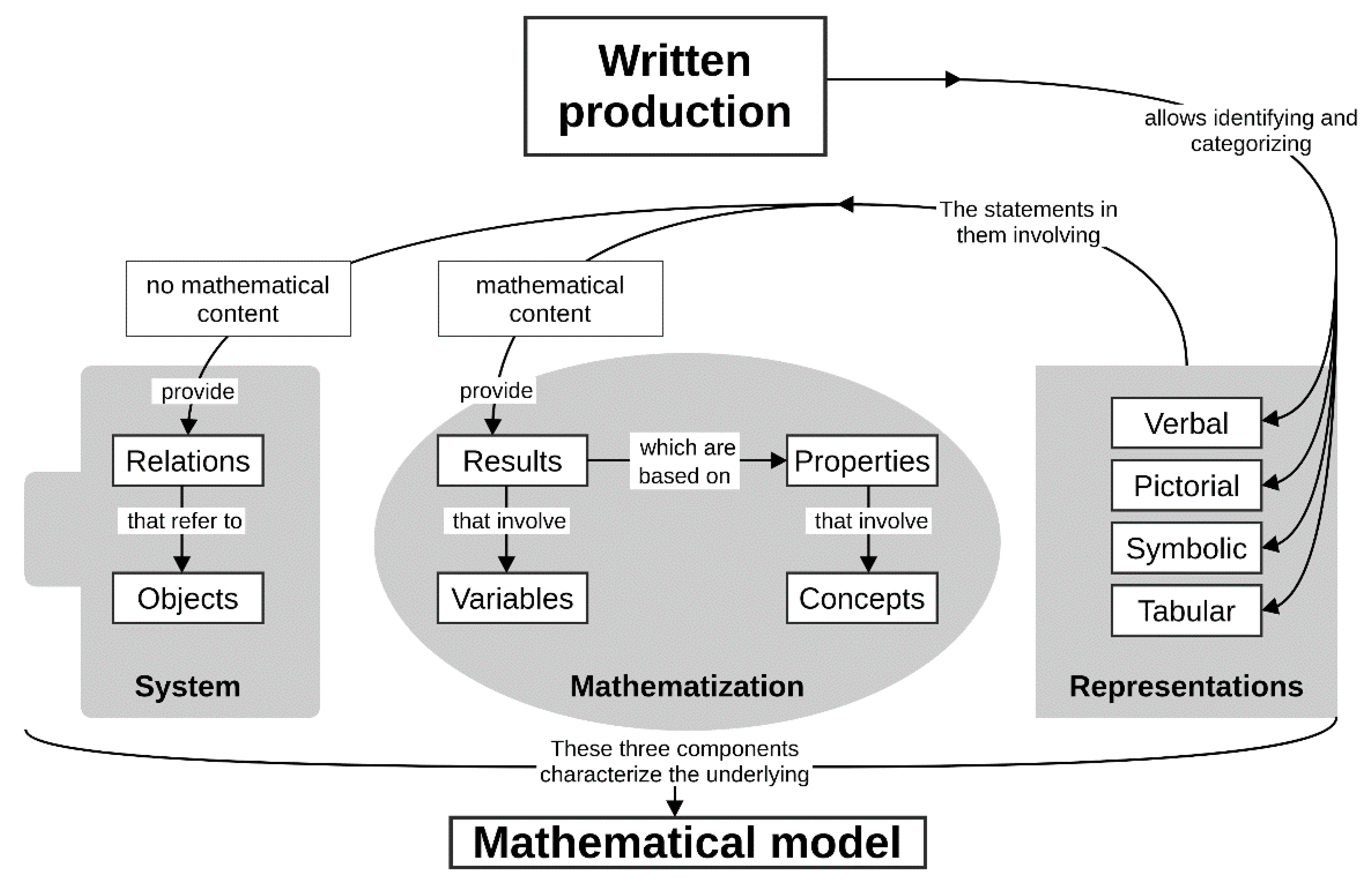
| Statements | Entities They Refer to | |
|---|---|---|
| Knowledge applied to the system | Results | Variables |
| Conceptual mathematical knowledge | Properties | Concepts |
| System | Mathematization | Representations |
|---|---|---|
| Relations (may include new knowledge obtained) | Results | Verbal (written) |
| Variables | Pictorial | |
| Objects | Properties | Symbolic |
| Questions | Concepts | Tabular |
| Characterization of the model | ||
| System | Mathematization | Representations |
|---|---|---|
| Relations | Results | Verbal |
| -The surface area of the Capitol holds 97,096 people. -Obama’s inauguration was attended by 1,504,988 people (answer to the question). | -The ground plan of the building (Capitol) is rectangular, measuring 106 m × 229 m and 24.274 m2 in area. -The area occupied by people is about 15 and a half times that occupied by the ground plan of the Capitol. -There is room for 4 people per square meter. | -”Provide an estimate of the number of people who attended Obama’s inauguration ceremony.” -“Estimating that the building is rectangular in shape”. -“…so that the rectangle on which the capitol sits has been reproduced 15 and a half times on the enclosed plan”. -“…considering that each square meter has room for 4 people”. |
| Objects | Variables | Pictorial |
| -Capitol Park -People who attended the inauguration -Capitol building | -Area of the Capitol (AC) -Total area occupied by people in the park (AP) -Number of times the capitol fits in the area occupied by people (nC) -Number of people that fit in 1 m2 (d) |  (Satellite image of a moment of the inauguration)  |
| Questions | Properties | Symbolic (integrated into verbal discourse): |
| -Estimate the number of people who attended Obama’s inauguration | -Formula for the area of the rectangle -Extensive property of the area -Invariance of area to rigid motion |  They include some non-numerical symbols such as the formula for the area of the rectangle and “m2”. They do not use proper symbols for persons as a unit of measurement or for the variables used. |
| Concepts | Tabular 1 | |
| -Rectangle -Area -Density (people/m2) | ||
| Characterization of the model used: the number of people p who attended the inauguration can be estimated using p = AP d = AC nC d | ||
| System | Mathematization | Representations |
|---|---|---|
| Relations | Results | Verbal |
| -Taking advantage of a corner of the classroom allows play centers to be set up in both classrooms | -The play center should occupy a quarter of the classroom. -The maximum amount of 10 m of fencing. -One wall in the first classroom measures 7.6 m and one wall in the second classroom measures 8.7 m (these data allow one to calculate the measurements using the grid). -The side of the grid in classroom 1 is 1.27 m (actual measurement). -The dimensions of the rectangle that divides the first classroom into four equal parts are 3.8 m and 6.35 m. Its area is 24.13 m2. -This rectangle cannot be the play center, since there is no fence (this is implicit). -The square root of 24, 13 is 4, 91. -A square (leaning on the corner) of side 4.91 m is an admissible play center in classroom 1. -With this play center, there would be 0.18 m of fence left over. -The side of the grid in classroom 2 is 1.24 m (actual measurement). -Classroom 2 is divided into two shapes: (i) a rectangle of dimensions 9.94 m × 6.21 m, whose area is 61.77 m2 and (ii) a right triangle whose legs are 2.48 m and 9.94 m, and whose hypotenuse is 10.23 m. The area of this triangle is 12.37 m2. -The area of classroom 2 is 74.14 m2. -The area of the play center to be located in classroom 2 is 18.53 m2. -The square root of 18, 53 is 4, 30. -A square (leaning on the corner) of side 4.30 m is an admissible play center in classroom 2. -With this play center there would be 1.40 m of fencing left over. | -“…the play centers must occupy exactly a quarter of the classroom.” -“The school has 10 m of this fence, but cannot afford to spend money on more.” -“…you have a scaled map of the classroom below.” -“…explain how the fence could be placed and how much fence would be left over.” -“…if the play center can be set up in the 4-year-old classroom with the ten meters of fence and how much fence would be left over.” -“…invent a new one that does work in both classrooms. Use it to explain how the fence should be placed in each of the classrooms and how much fence would be left over in each case.” -“By calculating the area, we can see that there is not enough meters of fence [Classroom 1].” -“Therefore, in order to use it [the fence], it would have to be in the shape of a square of side 4.91 m.” -“Thus, 0.18 m [of fence] would be left over.” -“By calculating the area of the figure, we can see that there are not enough meters of fence [Classroom 2]” -“In order to use it [the fence], it would have to be in the shape of a square of side 4.30 m” -“Thus, there would be 1.40 m [of fence] left over.” -“In both cases we have to put the play center in a square in one corner of the classroom.” -“Thus, the play center will be square in shape.” |
| Objects | Variables | Pictorial |
| -Play center -Fence | -Classroom area (A) -Side of the square defining the play center (l) |  (Plans of classrooms provided) 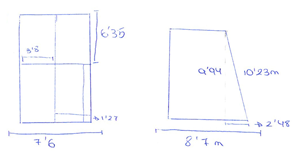 |
| Questions | Properties | Symbolic |
| -Can the play center be set up in the first classroom? If so, how can it be done? How much fence is left over? -Is the method used also applicable to the second classroom? If so, how? How much fence is left over? -If the method applied in the first classroom is not valid for the second one, explain why and find a method to place the fence that works in both classrooms. | -Extensive property of length -Formula of the area of the rectangle and the square -Extensive property of area -Taking the square root is the inverse operation of squaring |  -Integrated into verbal discourse:  -Calculations not integrated in the text 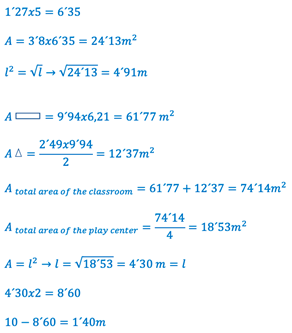 Proper symbolism for the area of a rectangle Usual notation for the area (A) and for the side of the square (l) |
| Concepts | Tabular 1 | |
| -Plane figure -Length of a segment (the fence) -Unit of measure/scale -Fraction -Length of the perimeter of a plane figure -Area of a plane figure -Square root -Square of a number | ||
| Characterization of the model used: a square of side the root of a quarter of the area of the classroom located in a corner of the classroom is a play center that complies with the regulations | ||
Publisher’s Note: MDPI stays neutral with regard to jurisdictional claims in published maps and institutional affiliations. |
© 2021 by the authors. Licensee MDPI, Basel, Switzerland. This article is an open access article distributed under the terms and conditions of the Creative Commons Attribution (CC BY) license (https://creativecommons.org/licenses/by/4.0/).
Share and Cite
Montejo-Gámez, J.; Fernández-Ahumada, E.; Adamuz-Povedano, N. A Tool for the Analysis and Characterization of School Mathematical Models. Mathematics 2021, 9, 1569. https://doi.org/10.3390/math9131569
Montejo-Gámez J, Fernández-Ahumada E, Adamuz-Povedano N. A Tool for the Analysis and Characterization of School Mathematical Models. Mathematics. 2021; 9(13):1569. https://doi.org/10.3390/math9131569
Chicago/Turabian StyleMontejo-Gámez, Jesús, Elvira Fernández-Ahumada, and Natividad Adamuz-Povedano. 2021. "A Tool for the Analysis and Characterization of School Mathematical Models" Mathematics 9, no. 13: 1569. https://doi.org/10.3390/math9131569
APA StyleMontejo-Gámez, J., Fernández-Ahumada, E., & Adamuz-Povedano, N. (2021). A Tool for the Analysis and Characterization of School Mathematical Models. Mathematics, 9(13), 1569. https://doi.org/10.3390/math9131569







